
Puerto Rican cuisine consists of the cooking style and traditional dishes original to Puerto Rico. It has been primarily a fusion influenced by the ancestors of the Puerto Rican people: the indigenous Taínos, Spanish Criollos and sub-Saharan African slaves. As a territory of the United States, the culinary scene of Puerto Rico has also been moderately influenced by American cuisine.

Fried rice is a dish of cooked rice that has been stir-fried in a wok or a frying pan and is usually mixed with other ingredients such as eggs, vegetables, seafood, or meat. It is often eaten by itself or as an accompaniment to another dish. Fried rice is a popular component of East Asian, Southeast Asian and certain South Asian cuisines, as well as a staple national dish of Indonesia. As a homemade dish, fried rice is typically made with ingredients left over from other dishes, leading to countless variations. Fried rice first developed during the Sui dynasty in China.

Arroz a la cubana or arroz cubano is a rice dish popular in Spain, the Philippines, and parts of Latin America. Its defining ingredients are rice and a fried egg. A fried banana and tomato sauce (sofrito) are so frequently used that they are often considered defining ingredients too.
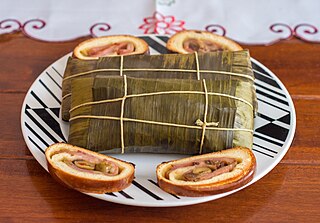
Hallaca is a traditional Venezuelan dish. Its origin is indigenous, but raisins, capers, olives, and sometimes bits of bacon were added in the 16th Century and after by settlers from the Iberian peninsula. Hallaca consists of corn dough stuffed with a stew of beef, pork, or chicken and other ingredients such as raisins, capers, and olives, fresh onion rings, red and green bell pepper slices. There are vegetarian hallacas, made with black beans or tofu. Hallacas are folded in plantain leaves, tied with strings, and boiled. The dish is traditionally served during the Christmas season and has several regional variants. It has been described as a national dish of Venezuela. Some speculate it originated from the Orinoquia. Characteristic of the hallaca is the delicate corn dough made with consommé or broth, and lard colored with annatto. Hallacas are also commonly eaten in eastern Cuba, Trinidad where it is called pastelle, and parts of Colombia, Ecuador, Aruba, and Curaçao.

Mofongo is a dish from Puerto Rico with plantains as its main ingredient. Plantains are picked green, cut into pieces and typically fried in more modern versions but can be boiled in broth or roasted, then mashed with salt, garlic, broth, and cooking oil in a wooden pilón. The goal is to produce a tight ball of mashed plantains that will absorb the attending condiments and have either pork cracklings (chicharrón) or bits of bacon inside. It is traditionally served with fried meat and chicken broth soup. Particular flavors result from variations that include vegetables, chicken, shrimp, beef, or octopus packed inside or around the plantain orb.

Sofrito, sofregit, soffritto, or refogado, is a basic preparation in Mediterranean, Latin American, Spanish, Italian and Portuguese cooking. It typically consists of aromatic ingredients cut into small pieces and sautéed or braised in cooking oil for a long period of time over a low heat.

Rice and beans, or beans and rice, is a category of dishes from many cultures around the world, whereby the staple foods of rice and beans are combined in some manner. The grain and legume combination provides several important nutrients and many calories, and both foods are widely available. The beans are usually seasoned, while the rice may be plain or seasoned. The two components may be mixed together, separated on the plate, or served separately.
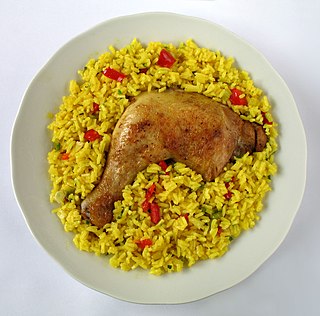
Arroz con pollo is a traditional dish of Latin America. It typically consists of chicken cooked with rice, onions, saffron, and a potential plethora of other grains or vegetables. In the Dominican Republic it is alternately called locrio de pollo, and in Saint Martin it is called lokri or locreo.
Green bananas are unripe bananas used in cuisines worldwide. They have a firmer texture and a starchy, mildly astringent taste compared to their ripe counterparts.

Picadillo is a traditional dish in many Latin American countries including Mexico and Cuba, as well as the Philippines. It is made with ground meat, tomatoes, and also raisins, olives, and other ingredients that vary by region. The name comes from the Spanish word picar, meaning "to mince".

Cuchifritos or cochifritos refers to various fried foods prepared principally of pork in Spanish and Puerto Rican cuisine. In Spain, cuchifritos are a typical dish from Segovia in Castile. The dish consists of pork meat fried in olive oil and garlic and served hot. In Puerto Rico they include a variety of dishes including morcilla, rellenos de papa, and chicharron, and other parts of the pig prepared in different ways. Some cuchifritos dishes are prepared using cooking plantain as a primary ingredient. Cuchifritos vendors also typically serve juices and drinks such as passionfruit, pineapple, and coconut juice, as well as ajonjolí, a drink made from sesame seeds.

Pasteles, also pastelles in the English-speaking Caribbean, are a traditional dish in several Latin American and Caribbean countries. In Puerto Rico, the Dominican Republic, Venezuela, Panama, Trinidad and Tobago, and the Caribbean coast of Colombia, the dish looks like a tamal. In Hawaii, they are called pateles in a phonetic rendering of the Puerto Rican pronunciation of pasteles, as discussed below.
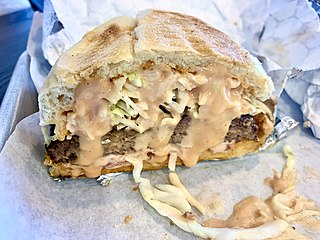
Dominican cuisine is made up of Spanish, Indigenous Taíno, Middle Eastern, and African influences. The most recent influences in Dominican cuisine are from the British West Indies and China.
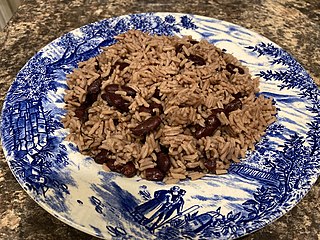
Rice and peas or peas and rice are traditional rice dishes within some Caribbean countries. The 'peas' used in this dish by some countries are traditionally pigeon peas otherwise called 'Gungo peas' in the Caribbean. Either kidney beans or pigeon peas are generally used for this dish. Rice and peas recipes throughout the Caribbean vary, with each country having their own way of making it and name of calling it, and are similar only by the two main ingredients which are the legumes (peas/beans) used and rice to form a mixture. The name "rice and peas" originally is used by Jamaicans to identify the dish, while other countries have different names for it.

Moro de guandules is a rice and pigeon pea dish from the Dominican Republic.
Arroz con maíz is a Latin American dish with rice and corn cooked in one pot.

Asopao is a family of stews that can be made with chicken, pork, beef, shrimp seafood, vegetables, or any combination of the above. Asopao is Puerto Rico's national soup and one of the most important gastronomic recipes in Puerto Rico.
Arroz junto is a Puerto Rican rice dish cooked with beans and meat in one pot.
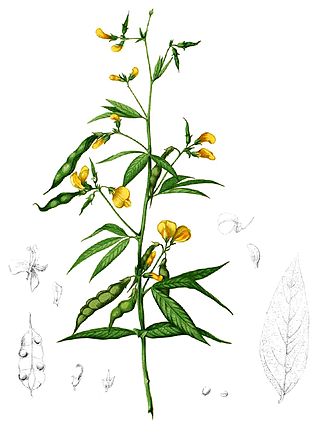
The pigeon pea or toor dal is a perennial legume from the family Fabaceae native to the Eastern Hemisphere. The pigeon pea is widely cultivated in tropical and semitropical regions around the world, being commonly consumed in South Asia, Southeast Asia, Africa, Latin America and the Caribbean.

Pastele stew is a Hawaii inspired pork stew of Puerto Rican origin. It is an adaptation of the dish pasteles introduced by the Puertorriqueños who came to work on the sugar plantations in the early 1900s. Pastele making is often a laborious task reserved for special occasions and holidays such as Christmas. Pastele stew was developed as a simplified everyday version.


















